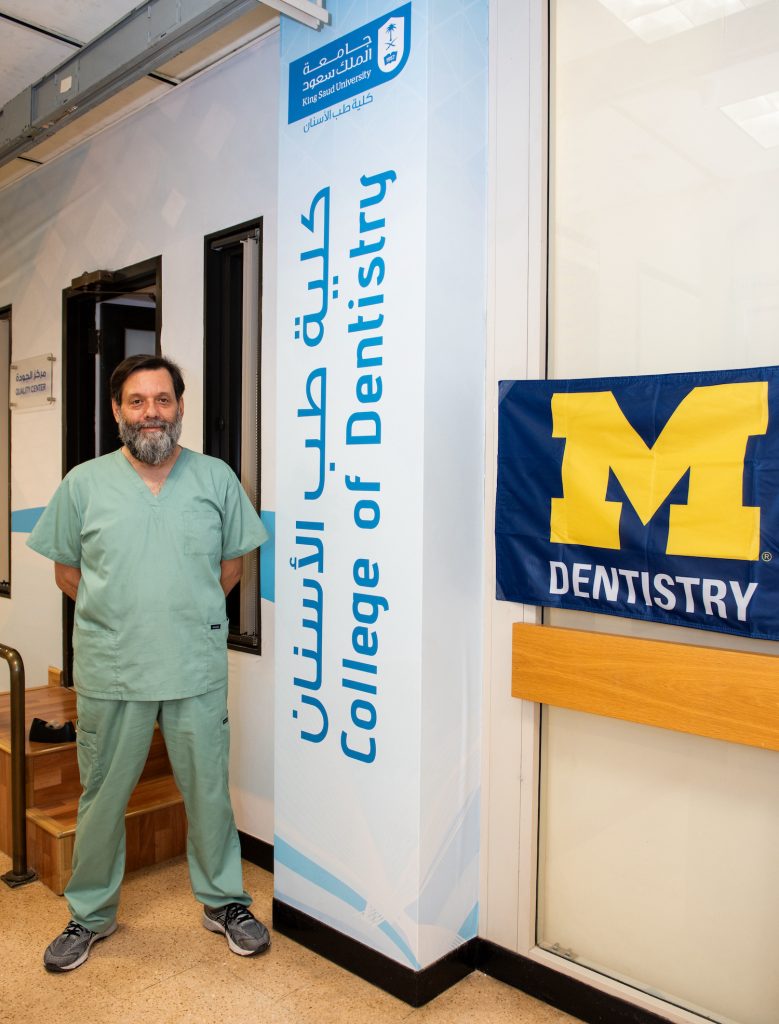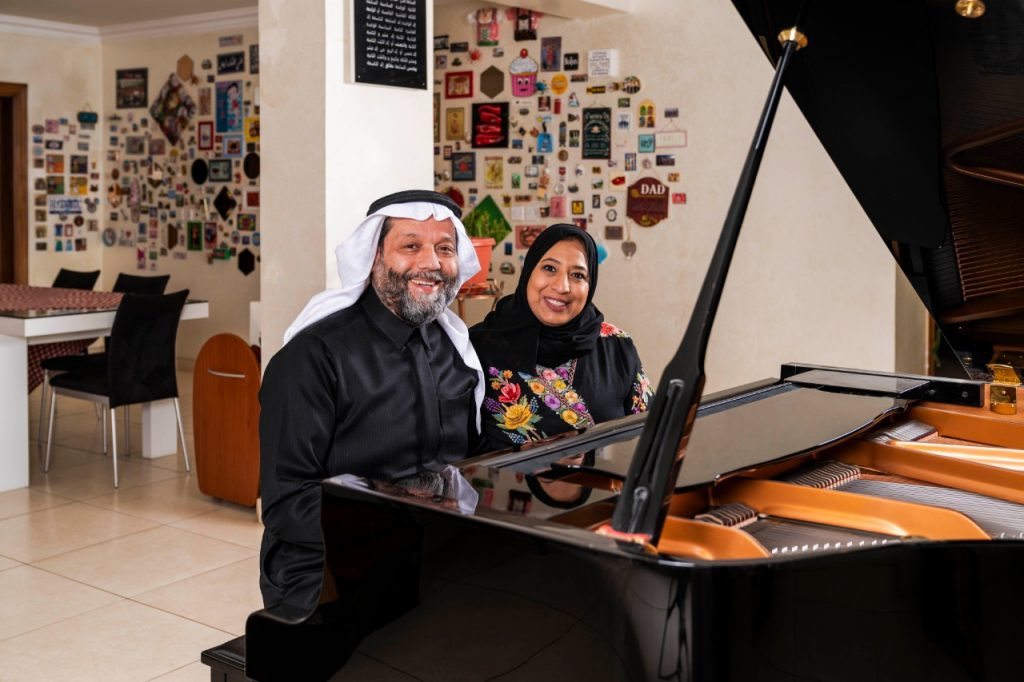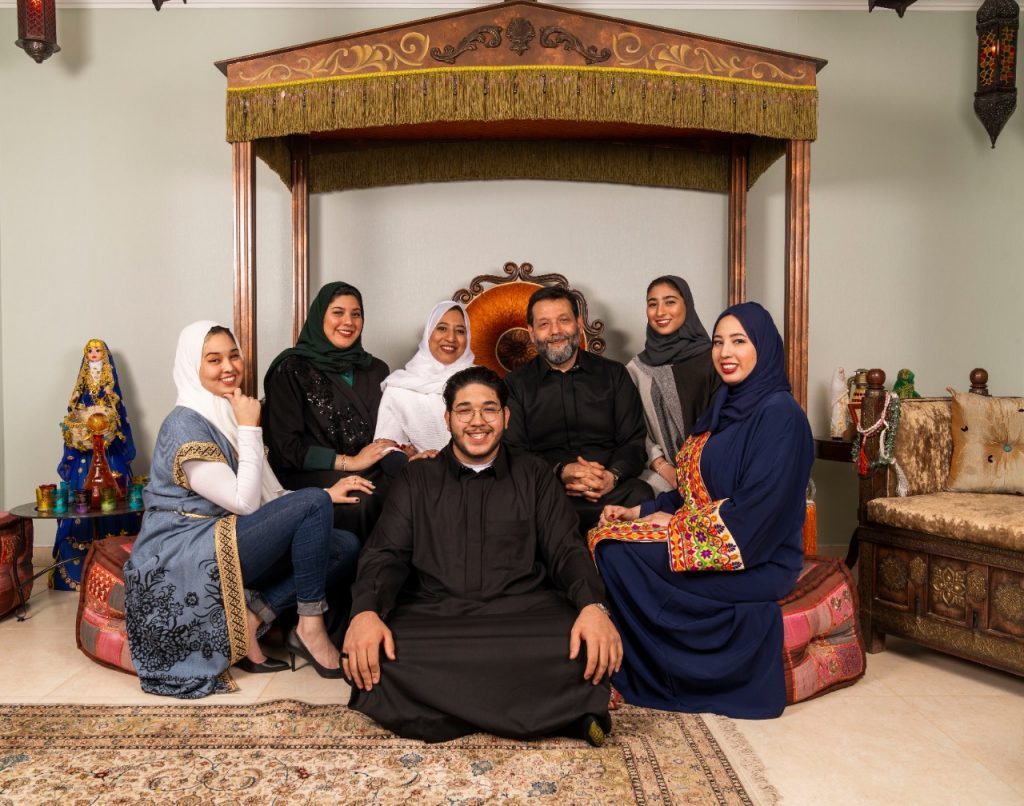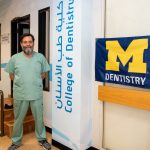Alumni Profile: The ongoing international educational journey of Dr. Esam Tashkandi, MS in Prosthodontics (1993), PhD in Oral Health Sciences (1999)13 min read
This profile is one in an ongoing series highlighting School of Dentistry alumni, donors and students.
___________________________

Dr. Esam Tashkandi is an Associate Professor in the Department of Prosthodontics at the College of Dentistry at King Saud University in Riyadh, Saudi Arabia. A native of Riyadh, he completed dental school and a general practice internship program there before coming to the University of Michigan School of Dentistry in 1991 for a master’s degree in prosthodontics. After finishing the MS in 1993, he stayed at the U-M dental school for a post-graduate program in implant dentistry, followed by a five-year course of study that led to his PhD in Oral Health Sciences in 1999. During his PhD program, he also completed a fellowship in dental surgery at the Royal College of Surgeons of Edinburgh in Scotland. Dr. Tashkandi returned to King Saud University in 1999 and has remained on the dental school faculty there over the last 25 years.
Concurrent with Dr. Tashkandi’s advanced studies at U-M, his wife, Ebtissam Murshid, earned her master’s degree in pediatric dentistry at the U-M dental school, followed by a PhD at the U-M School of Public Health.
Dr. Tashkandi and three other students comprised the first cohort of what was then the U-M School of Dentistry’s new PhD in Oral Health Sciences program started in 1994. This year marks the 30th anniversary of the start of the program, with the dental school planning a symposium October 3-4 to mark the anniversary. One of Dr. Tashkandi’s classmates in that first PhD cohort was Dr. Jacques Nör, who became Dean of the U-M School of Dentistry last August.
In the following Question-and-Answer format, Dr. Tashkandi discusses his academic journey from Saudi Arabia to the University of Michigan School of Dentistry and back. He fondly remembers the nine years he and his wife lived in Ann Arbor. He is grateful for the education he received, the faculty and researchers he met, the friends he made and how his studies have influenced the rest of his career in academia.
Q: What led to your initial decision to come to the University of Michigan dental school for your master’s degree in prosthodontics, from 1991-93? Why U-M?
A: While studying to become a dentist at King Saud University, I recall at least six major required textbooks throughout the dental curriculum were authored by legendary faculty members from U-M. So it was a no-brainer for me that I wanted to go to the root and tap this wonderful resource. I remember arranging an interview tour to the six campuses that my wife and I had applied to in the U.S. Although that trip took place in the winter of 1990, and most of the towns were freezing cold, something about Ann Arbor for both my wife and me was mesmerizing. The small university-town vibes, the Diag and the Michigan League felt charming. We both concurred that this is no doubt a very conducive environment to learn and that if we got accepted in our respective programs, we would come in a heartbeat. Fortunately, I got accepted in five of the six programs I had applied for and did not hesitate for a second to come to U-M.
Q: Once you earned your master’s degree, what influenced you to stay for the post-graduate program in implant dentistry, from 1993-94? And, similarly, what went into your decision to join the first cohort of the PhD in Oral Health Sciences program from 1994-1999?
A: Implant dentistry was such a new area in dentistry and there was no structured programs as such. So I approached my mentor, the late professor Brien Lang and told him that I would like to do both the surgery and the restorations for the implant cases. That would involve obtaining approval from either Periodontics or Oral Surgery departments. Matters were a bit volatile at that time and I got a lot of resistance from both departments. Who is this prosthodontist who dares encroach on our turf? I explained to both heads of the departments that I pose no threat and I only want to learn how difficult it is to do the surgery, which would help me become a better prosthodontist. And the diplomacy worked. I was allowed to work under the supervision of the head of the department to place implants as long as I promised to complete the prosthodontic work for the patients. The continuing education department created for me a customized one-year training program as such. It was definitely a great learning experience.
As for the decision to join the Oral Health Sciences program, my wife and I decided that we wanted to pursue academic careers so it was clear to both of us that a doctoral degree would be beneficial and valuable. At that time, U-M dental school offered two options for a dual-degree doctorate. Either with the school of medicine for biologic research track or the school of engineering for material science research track. I had already applied and was accepted at Ohio State University, which some of my friends considered as high treason. Fortunately, at that time, U-M dental school Dean Bernie Machen, who was a visionary, had decided to summon all the faculty who hold a PhD degree and were in all the different departments. He put them under the watchful eye of faculty member Charlotte Mistretta and created the OHS program. I immediately jumped at the idea of being able to stay in Ann Arbor for a few more years. My wife Ebtissam, who had just completed her master’s degree in pediatric dentistry, was accepted in the doctoral degree program at the School of Public Health. We both hit the jackpot.

Q: What are your memories of being in that first PhD cohort with just three other students?
A: The first term that comes to mind is guinea pigs. There was no doubt that being the first batch meant we were subjected to a lot of experimenting. Many of the policies were being written and amended as we were going through. I remember being the first student member of the program’s executive committee, which was a great learning experience for me at the time and later when I was involved in creating several new programs at King Saud University. The program was extremely intense while enriching.
Q: One of your PhD classmates, Jacques Nör, is now Dean of the U-M dental school. What do you recall about your time together in the program, or previously since you had met when Jacques was pursuing his pediatric dentistry graduate degree?
A: I first met Jacques in the summer of 1992. He had just arrived in Ann Arbor from Brazil and his guitar was slung behind his back. He and Ebtissam were classmates in the master’s program in pediatric dentistry. Later we became classmates in the OHS program. Ever the charmer, he would always get better grades than me by his smarts and also by his charisma. He was always very dedicated to accomplishing the task at hand with perfection. At the same time, when it was time to play, he was the man. We have a lot of fond memories together.
Q: Which U-M faculty members had the most impact on your education, research and future career during your nine years at the U-M dental school?
A: The list is quite long but some names stand out. First, the late Brien Lang, my mentor for the duration of my stay. In prosthodontic program, Mike Razzoog was a great teacher and a friend. Later in the OHS program I was influenced by many legends starting with my supervisor Bill O’Brien. Christian Stohler, Bill Johnston and Jim McNamara all left indelible marks on my carreer. Dan Chiego was my academic advisor but he knows that he was much more than that for me. And, of course, none of this would have happened without the diligence and persistence of Charlotte Mistretta.
Q: After you left U-M in 1999, you’ve been a faculty member and leader of various departments and initiatives at King Saud University. What is it that you like about your work in higher education and what would you list as your top accomplishments there?
A: I like to think about it from the perspective of overall impact. Even the best clinician in his or her field might be able to treat approximately 10,000 people over the course of their careers. However, as an educator, I may be able to teach and train one thousand dentists who each will go out and treat 10,000 patients properly. So the impact becomes logarithmic.
As for my top accomplishment, I guess with the help of my colleagues and a generous grant from several dental manufacturers, we were able to introduce dental implants as a formal requirement in the dental curriculum for the students. Consequently, the first modality of treatment that comes to the clinician’s mind changed from a fixed partial denture to a single dental implant. I like to think that by doing so we were able to preserve a lot of valuable tooth structure.
OHS-PhD program to celebrate 30 years
On Thursday and Friday, October 3-4, 2024, the University of Michigan School of Dentistry will host a celebration marking 30 years of its Oral Health Sciences PhD program. It was started in 1994 to establish future leaders in academic research who would specialize in craniofacial biology and oral health sciences. In the three decades since members of the first cohort graduated in 1999, the program has produced 58 graduates, with 28 now serving as faculty members and two becoming deans, including Dr. Jacques Nör, the current U-M dental school dean. The program’s impact extends beyond individual careers, shaping the landscape of oral health research and education globally. The October anniversary event will feature panels with current students and program alumni, talks from the current leaders of the program, elevator-pitch-like presentations from alumni about their current work in the field, and a Friday night reception. Check the event website for more details as they become available.
Q: Tell us about your interest in color science as it relates to dentistry and your specialty in prosthodontics. What is it about color science that led you to pursue this interest, working with the Society of Color and Appearance in Dentistry and other experts in the field.
A: Color science in dentistry is such an enigma. Although it has a central role in all aspects of dentistry both in terms of assessment of color or in terms of duplicating or recreating it in an artificial substance. The field today, unfortunately, remains as ambiguous as it was when I first entered the field three decades ago. The reason, in my mind, is that although there have been many technological advancements in the field, assessment of color and appearance will always end up being done by a human with his or her eyes. The amount of subjectivity and variability from one individual to another makes the outcome less predictable. Furthermore, the tooth with its complexities in terms of shape, form, structure or environment makes a nightmare for the assessor. It is unlike the fender of a car or a wall at home to be painted were the specimen behaves well for the assessor. Having said that, the intrigue and passion I have for this field is still enormous.
Q: Your wife, Ebtissam, also earned degrees at U-M. What are her specialties?
A: Yes, Ebtissam obtained her master’s degree in pediatric dentistry and a doctorate in public health from the School of Public Health under the mentorship of Brian Burt. Her research was mainly on fluoride. She has had a spectacular academic and clinical career. Her main research focus, which culminated into her professorship, was related to autism. Recognized as the leading expert in the region, she lectures a lot about it. Also, she has been instrumental in establishing several dedicated centers for providing free dental care for the special needs patients.
Q: You seem to have fond memories of Ann Arbor and the university in terms of how it affected your family life during those nine years, two degrees and additional training you completed.
A: Are you kidding? These were the best days of our lives. We came to Ann Arbor when our first daughter Nada was a one-year-old. Two more daughters came along later, Hala and Oula. Our fourth daughter, Ruba, was born in Riyadh one month after we returned. Our son Faisal was born a couple of years later. Nada is now an American and Canadian board-certified orthodontist, trained at Boston University and teaching and practicing in Riyadh. Hala wanted to be far away from any health-related field so she studied applied linguistics and became a well-recognized journalist in the Kingdom. Oula is following her father’s footsteps; she is currently finishing her prosthodontic residency and master’s degree at Tufts University. Ruba studied medicine and graduated last year; she is now very keen on joining a residency program in North America in obstetrics and gynecology. Faisal decided to make a career in business; in addition to almost graduating with a degree in marketing, he has established a small business in the food and beverage industry.
Q: Your life story so far has taken a very interesting path, from Riyadh to Ann Arbor to Scotland and back to Riyadh with continued academic and professional connections around the world.
A: Life is interesting. The set course of my journey was destined to be a bit convoluted, however, it was extremely fulfilling. Leaving Ann Arbor and heading back home was inevitable in our minds. There was a moral and cultural obligation in our minds to go back and pay our dues to our family, people and country. A quarter of a century later, one reflects on how fortunate a person can be to be given such rewarding opportunities in life. The best asset I have acquired over all these years is the love and friendship of so many wonderful people around the world who have enriched my life. I have no doubt that giving is the best way to have both joy and happiness in life.

###
The University of Michigan School of Dentistry is one of the nation’s leading dental schools engaged in oral healthcare education, research, patient care and community service. General dental care clinics and specialty clinics providing advanced treatment enable the school to offer dental services and programs to patients throughout Michigan. Classroom and clinic instruction prepare future dentists, dental specialists and dental hygienists for practice in private offices, hospitals, academia and public agencies. Research seeks to discover and apply new knowledge that can help patients worldwide. For more information about the School of Dentistry, visit us on the Web at: www.dent.umich.edu. Contact: Lynn Monson, associate director of communications, at [email protected], or (734) 615-1971.

